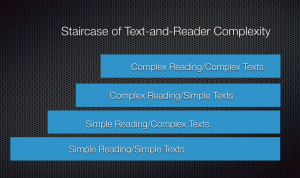There is no Right Way to support students in small groups. There, I said it (and so does Lucy Calkins in her Guide to the

Adapted from Barnhouse’s Readers Front & Center.
Reading Workshop for Primary Grades (103) and Intermediate Grades (69)). If the purpose of small group instruction is to design the learning to meet readers where they are in terms of their complexity of thinking and the complexity of texts they read, then how can there only be one way to design that learning?
Guided Reading
Calkins contends guided reading is not the only answer to meeting students’ needs in small groups, although it is one powerful way to support
- English Language Learners (with work on scaffolding comprehension and vocabulary)
- students moving up levels in text complexity
- students who don’t use a balance of cueing systems to tackle their reading (primary mostly)
- students who struggle to hold onto meaning across pages
One Size Does Not Fit All Readers
 However, if this is our only concept of small group work, one size does not fit all. We need to “outgrow any feeling that every small group proceeds in the same way” (Calkins, 72, Guide to the Reading Workshop for Intermediate Grades).
However, if this is our only concept of small group work, one size does not fit all. We need to “outgrow any feeling that every small group proceeds in the same way” (Calkins, 72, Guide to the Reading Workshop for Intermediate Grades).
At today’s chat and chew, we looked at various structures Lucy recommends for small groups, whether those groups are guided groups, strategy groups, groups self-assessing with the learning progressions, shared reading groups, interactive writing groups, or any other kind of group your mind can envision! (See Chapter 8 in Calkins’ Guide to the Reading Workshop for Intermediate Grades or Chapter 9 in Calkins’ Guide to the Reading Workshop for Primary Grades to learn more.)
Questions We Continue Thinking About
-How can teachers use repeatable structures for small groups to reduce their time spent planning and increase their time listening to students?
-How do we balance our desire to confer with our work with small groups?
-How can we use Calkins’ tips in these chapters to shrink the time we spend with each small group and to create the time we want for conferring?
Your Turn
We’d love to hear your thoughts as you dig into this one chapter in Calkins’ Guide to the Reading Workshop for your grade level.
